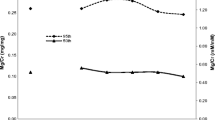Abstract
The aim of this study was to establish the age related reference percentile values for urinary calcium excretion in healthy Turkish children, and to determine the frequency of hypercalciuria and also the factors affecting urinary calcium excretion. A cross-sectional study was performed in Aydın, in western Turkey during winter. Study population was constituted from seventeen districts of this region (sample size was calculated from a formula using the results of the last population census) by stratified and random sampling methods. Urinary calcium excretion was measured as the calcium/creatinine concentration ratio in the second non-fasting urine samples. A total of 2252 children (1132 male) with a mean age of 8.57 ± 4.44 years (ranged from 15 days to 15 years) were studied. The mean of urinary calcium/creatinine concentration ratio was calculated as 0.092 ± 0.123. The percentile values between 3rd and 97th for urinary calcium/creatinine concentration ratio according to age were calculated and shown as multiple line graphs. Hypercalciuria prevalence was found as 9.6% when the upper limit of urinary calcium/creatinine concentration ratio was accepted as 0.21. Urinary calcium/creatinine concentration ratio of the children from different districts, altitudes, and ethnic origins were statistically different. Poor negative correlations were found between urinary calcium/creatinine concentration ratio and age and weight. No differences in urinary calcium/creatinine concentration ratios were observed in terms of sexes, diet, physical activity, urolithiasis in the family, symptoms related to hypercalciuria, amount of calcium in drinking water, and urine strip analysis. In conclusion, reference values for urinary calcium/creatinine concentration ratios should be established for children in each country and also in each geographic region.
Similar content being viewed by others
References
Noe HN, Stapleton FB (1997) Hypercalciuria and calcium stone disease. In: Donell BO, Koff SA (eds). Pediatric Urology. Oxford University Press, Cambridge, pp 11–19
Milliner DS (2004) Urolithiasis. In: Avner ED, Harmon WE, Niaudet P (eds). Pediatric nephrology. Lippincott Williams &Wilkins, Philadelphia, pp 1094–1095
Milliner DS, Stickler GB (1992) Hypercalcemia, hypercalciuria and renal disease. In: Edelman CM (ed). Pediatric kidney disease. Little, Brown and Company, Boston, pp 1675–1677
Jones C, Mughal Z (2003) Disorders of mineral metabolism and nephrolithiasis In: Webb NJA, Postlethwaite RJ (eds). Clinical pediatric nephrology. Oxford University Press, New York, p 89
Kher K (1992) Urinary stone diseases. In: Kher KK, Makker SP (eds). Diagnostic nephrology. Mc Graw, NewYork, pp 699–723
So NP, Osorio AV, Simon SD et al (2001) Normal urinary calcium /creatinine ratios in African-American and Caucasian children. Pediatr Nephrol 16:133–139
Alconcher LF, Castro C, Quintana D et al (1997) Urinary calcium excretion in healthy school children. Pediatr Nephrol 11:186–188
Vachvanichsanong P, Lebel L, Moore ES (2000) Urinary calcium excretion in healthy Thai children. Pediatr Nephrol 14:847–850
Guignard JP, Santos F (2004) Laboratory investigations. In: Avner ED, Harmon WE, Niaudet P (eds). Pediatric nephrology. Lippincott Williams &Wilkins, Philadelphia, p 403
Moore ES, Coe FL, Mc Mann et al (1978) Idiopathic hypercalciüria in children: prevalence and metabolic characteristics. J Pediatr 92:906–910
Ghazali S, Barratt TM, Williams DI (1974) Urinary excretion of calcium and magnesium in children. Arch Dis Child 49:97–101
Hernandez MarcoR, Nunez Gomez F, Martinez Costa C et al (1988) Urinary excretion of calcium, magnesium, uric acid and oxalic acid in normal children. An Esp Pediatr 29:99–104
Esbjörner E, Jones IL (1995) Urinary calcium excretion in Swedish children. Acta Pediatr 84:156–159
Reusz GS, Dobos M, Byrd D et al (1995) Urinary calcium and oxalate excretion in children. Pediatr Nephrol 9:39–44
O’Brien KO, Abrams SA, Stuff JE et al (1996) Variables related to urinary calcium excretion in young girls. J Pediatr Gastroenterol Nutr 23:8–12
Kruse K, Kracht U, Kruse U (1984) Reference values for urinary calcium excretion and screening for hypercalciuria in children and adolescents. Eur J Pediatr 143:25–31
Sweid HA, Bagga A, Vaswani M et al (1997) Urinary excretion of minerals, oxalate, and uric acid in north Indian children. Pediatr Nephrol 11:189–192
De Santo NG, Di Iorio B, Capasso G et al (1992) Population based data on urinary excretion of calcium, magnesium, oxalate, phosphate and uric acid in children from Cimitile (southern Italy). Pediatr Nephrol 6:149–157
Shaw NJ, Wheeldon J, Brocklebank JT (1990) Indices of intact serum parathyroid hormone and renal excretion of calcium, phosphate and magnesium. Arch Dis Child 65:1208–1211
Kaneko K, Tsuchiya K, Kawamura R et al (2002) Low prevalence of hypercalciuria in Japanese children. Nephron 91:439–443
Safarinejad MR (2003) Urinary mineral excretion in healthy Iranian children. Pediatr Nephrol 18:140–144
Rath B, Aggarwal MK, Mishra TK et al (1994) Urinary calcium creatinine ratio and hypercalciuria. Indian Pediatr 31:311–316
Khalil NY, Ahmad S, Khan M et al (1998) Population based data on urinary excretion of various metabolites in children of north western region of Pakistan. J Pak Med Assoc 48:241–242
Manz F, Kehrt R, Lausen B et al (1999) Urinary calcium excretion in healthy children and adolescents. Pediatr Nephrol 13:894–899
Yarış N, Siga E, Kalyoncu M et al (2001) Trabzon bölgesi ilkokul çağı çocuklarında idrarda kalsiyum atılımı ve hiperkalsiüri sıklığı. çocuk Sağlığı ve Hastalıkları Dergisi 44:333–337
Ersoy B, Ertan P, Uyanık BS et al (2002) Sağlıklı okul çocuklarında idiyopatik hiperkalsiüri sıklığı.T Klin Pediatr 11:6–9
Bercem G, Cevit O, Toksoy HB et al (2001) Asymptomatic hypercalciuria: prevalence and metabolic characteristics. Indian J Pediatr 68:315–318
Author information
Authors and Affiliations
Corresponding author
Rights and permissions
About this article
Cite this article
Sönmez, F., Akçanal, B., Altıncık, A. et al. Urinary Calcium Excretion in Healthy Turkish Children. Int Urol Nephrol 39, 917–922 (2007). https://doi.org/10.1007/s11255-006-9013-9
Received:
Accepted:
Published:
Issue Date:
DOI: https://doi.org/10.1007/s11255-006-9013-9




